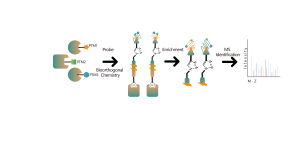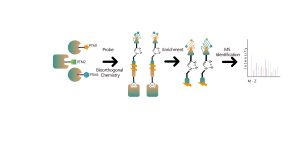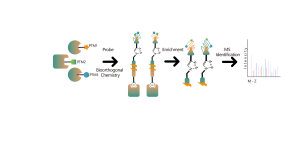-
Chemical Proteomics
Mass spectrometry-based chemical proteomics technology leverages Chemical Probes to analyze the Ligandability of thousands of proteins in cells or tissues simultaneously. Providing a drug-protein interaction network under physiological conditions. -
DIA-ABPP
abpp
-
Automated Chemoproteomic Workstation
ChomiX’s professional biological automation equipment AutoProtChemix can process 96 samples in batches each time, realizing full-process automation of protein extraction, quantification, probe labeling, protein purification, enzyme cleavage and separation. Compared with the existing process dominated by manual operation, this equipment can ensure the accuracy and stability of the experimental process.
-
ChomiX®-ClickKit-Cu/BTTAA C (Click Chemistry Kit)
BTTAA is a new generation of strongly water-soluble ligand, widely used in the CuAAC reaction in solution, matching fluorescein, biotin and other azide-modified reporter groups
-
Absolute Protein Quantification Analysis
Absolute Protein Quantification Analysis Absolute quantification analysis is a crucial technique in the field of proteomics, specifically designed to accurately determine the concentration or copy number of proteins or peptides in a sample. The core of this method lies in the precise calibration using known concentrations of the standards (usually isotopically labeled peptides). Absolute quantification analysis is of significant importance for both basic biological research and clinical appli... -
Targeted Proteomics Analysis
Targeted Proteomics Analysis Proteomics research can be divided into targeted and non-targeted proteomics based on whether the study focuses on specific types of proteins. Targeted proteomics is a research method that focuses on specific proteins or protein groups. It selectively detects and quantifies target proteins, providing highly sensitive and specific results, which are used to delve into protein functions and disease mechanisms. Compared to non-targeted proteomics, targeted prote... -
Untargeted Protein Qualitative/Quantitative Analysis
Untargeted Protein Qualitative/Quantitative Analysis In the field of drug development, scientists have been dedicated to exploring innovative therapies for specific diseases. Differential protein analysis has become a key tool for gaining insight into disease molecular mechanisms, identifying effective therapeutic targets, and providing critical clues and scientific evidence for the discovery and development of novel drugs. This technology empowers researchers to systematically detect changes... -
Protein Qualitative and Quantitative Analysis
Protein Qualitative and Quantitative Analysis As a core technology in modern biomedical research, protein qualitative and quantitative analysis, supported by the rapid development of mass spectrometry technology, has achieved precise identification and quantification of proteins. This technology plays a pivotal role in revealing the mysteries of life phenomena, exploring disease mechanisms, and discovering biomarkers. Currently, it is widely used in various fields: Biological Mechanism E... -
Serine/Threonine Post-Translational Modifications
Serine/Threonine Post-Translational Modifications Serine and Threonine Post-Translational Modifications (PTMs) refer to the chemical modifications that proteins undergo after synthesis, with phosphorylation and glycosylation being the most common forms of modification. The PTMs on serine and threonine residues mainly include phosphorylation and O-glycosylation. After modification, these amino acid residues can significantly alter the protein’s activity, stability, and interaction capabi... -

Lysine Post-Translational Modifications
Lysine Post-Translational Modifications Among the 20 amino acid residues in proteins, lysine (K) is one of the most common targets for various post-translational modifications (PTMs). With the rapid development of high-resolution mass spectrometry (MS) and immunoprecipitation purification techniques, multiple acylation reactions on lysine have been discovered in the past decade, including acetylation, succinylation, malonylation, glutarylation, crotonylation, butyrylation, and lactylation. Re... -

Cysteine Post-Translational Modifications Omics Analysis
Cysteine Post-Translational Modifications Omics Analysis Cysteine, with its remarkable reactivity, plays a pivotal role in protein structure and function. Serving as a nucleophilic reagent, redox catalytic center, metal ion ligand, and key site for conformational changes, it extensively participates in and profoundly influences protein activity and regulatory mechanisms. It’s worth noting that cysteine residues are prone to undergo various types of post-translational modifications (PTMs... -

Protein Post-Translational Modification (PTM) Omics Analysis
Protein Post-translational Modifications (PTMs) Analysis Based on Chemical Probes In addition to traditional antibody enrichment strategies, chemical, enzymatic, and metabolic labeling techniques have been progressively applied in the enrichment and identification of post-translational modifications (PTM) in proteins. The underlying principle involves using chemical reaction or enzyme catalysis to covalently attach specific molecular probes to target modifications or modifying res...

